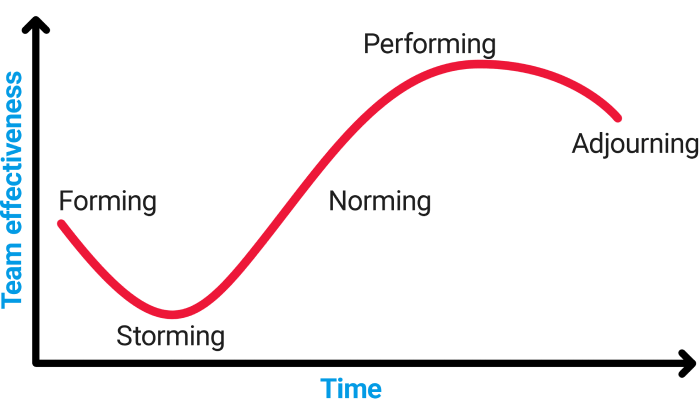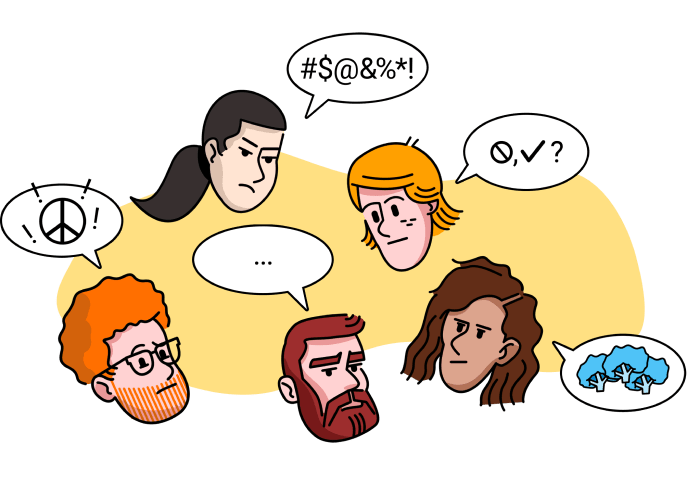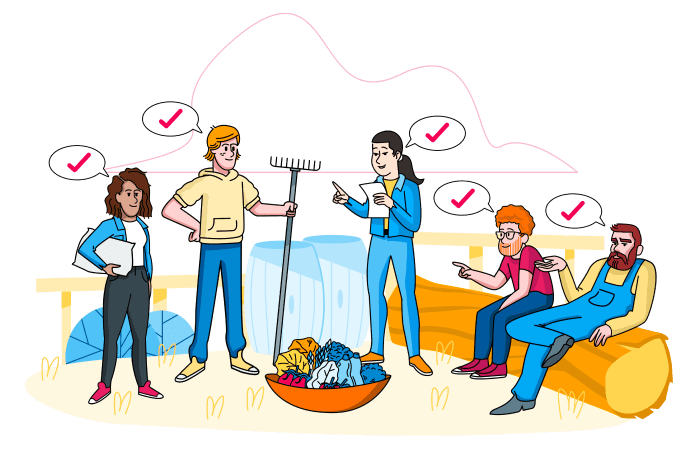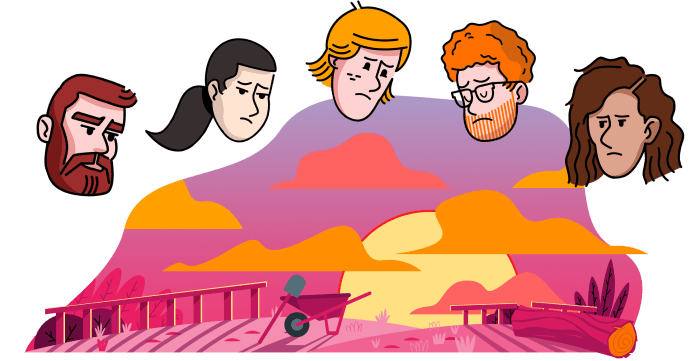The Stage Of Team Development In Which A Team Reaches Its Full Potential Is Called
The 5 stages of group development explained
No team is able to hit the ground running with a project upon their first meeting. Instead, they go through a complex process that involves the 5 stages of group development:
The Forming, Storming, Norming, Performing, and Adjourning stage.
In this blog post, you'll learn everything you need to know about these 5 stages of team development, including what they're about (+ illustrative examples), why they're so important, and how to facilitate them.
Table of contents
- What are the 5 stages of group development?
- Who invented the stages of group development?
- The Forming Stage
- The Storming Stage
- The Norming Stage
- The Performing Stage
- The Adjourning Stage
- Why are the stages of group development important?
- 11 tips on how to facilitate proper group development
What are the 5 stages of group development?
The stages of group development in organizational behavior and management are a theory of team development — a group-forming model that consists of 5 distinct stages.
According to this stages of group development model, each group or team is likely to go through the following connected 5 stages during their joint work:
- The Forming Stage — mainly characterized by team orientation.
⬇️
- The Storming Stage — mainly characterized by a power struggle.
⬇️
- The Norming Stage — mainly characterized by cooperation, integration, and unity.
⬇️
- The Performing Stage — mainly characterized by overall synergy.
⬇️
- The Adjourning Stage — mainly characterized by a sense of closure.

Image 1: Stages of group development diagram
Now, these 5 stages are vital to help you anticipate your team effectiveness, i.e. your ability to be efficient and productive with your work, both as individuals and as a group.
As the above diagram shows, the effectiveness of a team or group fluctuates over time, reaching its ultimate low in the Storming Stage (sometimes dubbed as "The Power Struggle Stage") and reaching its ultimate high in the Performing Stage (sometimes dubbed as the "The Synergy Stage").
Who invented stages of group development?
The first 4 stages of group development are also known as the "Forming-Storming-Norming-Performing Model" — they were established by Bruce W. Tuckman, an American Psychological Researcher, in 1965.
According to Tuckman, the listed stages are obligatory for a team to:
☑️ grow and progress
☑️ face challenges
☑️ face problems
☑️ find solutions for the listed challenges and problems
☑️ plan and tweak their individual and group workflows
☑️ reach their expected project goals
Tuckman only added the fifth and final stage (the Adjourning Stage) in 1977, together with Mary Ann C. Jensen who had previously reviewed his original paper.
By including the Adjourning Stage, Tuckman wanted to clearly cap off the process of group development, and provide teams with a stage they'll spend reflecting on what they've accomplished with their project (or didn't).
Tuckman would later go on to say that his group-forming model gained such popularity because the names of the first 4 stages formed a perfect rhyme — considering that they all end in "ming".
Now, he couldn't find a perfect rhyme for the 5. stage — hence, he named it "Adjourning", as retiring the team was his intended purpose for this stage. Some scholars would later go on to rename the 5. stage the "Mourning" Stage — because it is the best description for the emotion teams likely feel when their time on a team project is up.
Now that we understand the basics and origin of the stages of group development model, here's what each of the stages is about, in more detail, and with illustrative examples:
The stages of group development with examples, explained
Stage #1 — The Forming Stage

The Forming Stage ("team orientation" stage) – a) Project goals understood, b) Tasks assigned, c) Project timeline discussed
The Forming Stage is the one about team orientation :
Everyone is just getting to know one another, and they are all overly polite to each other because they are looking to be accepted among this new group of people.
For the same reasons, they may also be a bit uncertain and anxious.
They are also overly positive about the project, because it's new, and new is always exciting.
At this initial stage, a glimpse of a future project leader may emerge, as the person who possesses the largest knowledge about the project's subject takes unofficial charge.
The position of this unofficial leader may also be occupied by the strongest authority figure in the team.
Signs your team has entered the Forming stage:
- you understand the purpose of the group
- you understand the project goals
- you're talking about team members' skills
- you're assigning tasks, responsibilities, and individual roles
- you're laying down some ground rules about team management
- you're laying down some ground rules about team workflow
- you're discussing the team time management and expected project timeline
Example for Stage #1 — Forming
To illustrate the 5 stages of team development, let's look at the example of Daisy, Adam, Daniel, Mark, and Stella. The 5 of them are neighbors and they just moved to the countryside.
After a week of acquaintanceship, they realize they all have substantial experience in gardening.
So, they decide to split the fees, buy one of the neighboring fields, and grow a 120 sq feet vegetable garden.
They're all really excited about the prospect of having access to fresh vegetables every day — they understand the benefits such a project would have for their family's everyday meals.
The 5 of them get together every afternoon during a week to discuss plans.
A general idea of what types of vegetables they could grow is forming and includes tomatoes, cucumbers, zucchinis, and peppers. At the last moment, Daisy also suggests they grow 20 sq feet of broccoli.
They all agree with everyone's suggestions and are eager to get started.
Daisy will find the best location based on proximity to water supply, space, and sun exposure.
Adam knows how to test soil acidity and is familiar with soil supplements, so he wants to handle soil preparation.
Mark, Stella, and Daisy will handle sowing, while Adam will handle the fertilizing.
Daniel will make sure the garden is weed and pest-free at all times. Daisy suggests he also waters the garden, along with her, Mark, and Stella.
It's the end of March, and they want to have a fully-formed garden by the beginning of June.
Stage #2 — The Storming Stage

The Storming Stage ("power struggle" stage) – a) Open idea exchange, b) Dominant team members emerge, c) Questions and conflicts
The Storming stage is the one that brings about a power struggle :
So, team orientation is over — and team members are likely to forgo their previously held politeness.
Instead, they adopt an open exchange of ideas and opinions and learn about what it's really like to work together. This can lead to conflict, disputes, and competition, depending on how their expectations, workflows, ideas, and opinions differ.
Sometimes, subgroups may form around particular opinions or authority figures — which are all clear signs that team cohesion has not happened yet.
Unless the team is patient and tolerant of these differences as well as willing to address and work on them, the team and project cannot succeed.
Now, here's where you may wonder: well, if it's such an unpleasant affair, can the Storming Stage of group development ever be avoided?
Well, truth be told, some teams may skip this step altogether, all in the hope that they'll avoid unpleasant conflict and the clash of ideas.
However, this stage is crucial if you want your team to succeed — you won't get far with your project by sweeping vital questions and potential problems under a rug.
Signs your team has entered the Storming stage:
- the dominant team members emerge
- the less dominant team members find their way to the background
- questions about leadership and authority emerge (and should be answered)
- questions about rules, policies, and norms emerge (and should be answered)
- questions about evaluation and review emerge (and should be answered)
Example for Stage #2 — Storming
Now, this is where things get tense for Adam, Daisy, Daniel, Mark, and Stella as they set their plan into motion, while their 5 personalities and opinions clash.
Daisy called a lot of shots in the Forming stage, so she emerges as the dominant team leader in this stage. She proposes a clear schedule and takes charge of contacting the local store to see what supplies they can get here, and what supplies they may need to go to the city for. She wants to go to the city to buy seeds because they cannot get the broccoli seed she wants in the local store.
However, Daniel voices his concerns about Daisy's idea to grow broccoli in the first place — because he believes it's more difficult to grow the broccoli than the other vegetables.
Mark questions the fertilizer Adam wants to use, and Daisy agrees.
Moreover, Adam, who's generally a dominant personality, raises some other questions they were all too polite to discuss in the Forming Stage: how will they split the vegetables once the garden begins to produce?
Stella takes a back seat in their discussions as she's generally a more laid back person, and is fine with whatever they decide. Yet, Daniel wants her opinion about the broccoli, and she's expected to pitch in with the discussion about splitting the vegetables.
In the end, they manage to weather the storm of opinions.
Daisy has a change of heart about the broccoli.
Adam's choice of fertilizer prevails.
They're now left with 120 sq feet and 4 types of vegetables, so they decide to use 30 sq feet for each vegetable type.
They'll split the gardening fees equally, but they'll split the final products based on the number of people in their families, and their needs.
Stage #3 — The Norming Stage

The Norming Stage ("cooperation, integration, and unity" stage) – a) Easier group interactions, b) Team productivity increase, c) Team performance increase
This stage is the one that brings about a sense of cooperation, integration, and unity .
Of course, you can only move on to this more pleasant stage if you've addressed and answered all the vital questions from the previous, Storming Stage.
The team is already accustomed to each other's workflows, and most future disputes and conflicts generally become easier to overcome. The official (or unofficial) team leader takes a back seat much more than in the previous stages, and the individual team members are given their chance to shine.
In some cases, the Norming Stage may often be intersected by the Storming Stage. It may even revert to it unless the team makes the effort to communicate problems, and then learn from these interactions.
Signs your team has entered the Storming stage:
- group interaction becomes easier
- the team becomes more cooperative on the whole
- team productivity increases
- team performance increases
💡 To facilitate this transition from the Storming Stage to the Norming Stage, you're advised to incorporate team management software into your team workflow.
Here is the 20 best team management software you can try now.
Example for Stage #3 — Norming
Adam, Daisy, Mark, Daniel, and Stella are now mostly content with everyone's opinions concerning the type of fertilizer and seeds they'll use.
Daisy voices her passion for broccoli one more time. But, she's now quickly persuaded against the idea when Stella sends her a research paper on the subject.
They've polished out most questions and bought everything they need. To buy what they need, they've even made a road trip to the city together — they've used this time to bond and get to know each other better.
Daisie still stands out as the unofficial team leader (with Adam as her close second), but others are given a more prominent role as they all take over their duties.
Stage #4 — The Performing Stage

The Performing Stage ("team synergy" stage) – a) Clear roles and responsibilities, b) Mature way of handling issues, c) Well-organized team
The Performing stage is what your team is really after — in this stage, you and your team get to enjoy synergy .
If your team has reached this stage, you're on a clear path to success. You have a mature, well-organized group now fully-focused on reaching the project goals established in the Forming stage.
Team members have grown fully accustomed to each other's workflows. They respect and acknowledge each other's skills, talents, and experience.
They know exactly which team member to call to help with each type of problem that arises in the project.
And, what's most important, they trust that everyone involved will do their share of the work.
Bear in mind that not all teams reach this stage — some may falter at the earlier stages, due to the inability to properly address differences between team members or address problems as they emerge.
Signs your team has entered the Performing Stage:
- the organization in your team is now well-established
- the structure of roles and responsibilities is clear and straightforward
- the team has a tested, mature, and calm way of handling issues
Example for Stage #4 — Performing
With everything planned out, Daisy, Adam, Mark, Daniel, and Stella get to serious work.
Daniel consults with Adam about using a "weed'n'feed" combination to fertilize the soil and kill weeds at the same time (and cost). Ultimately, they decide against it.
Adam finishes soil preparation in a couple of days and lays down the fertilization schedule for the following period.
Mark, Stella, and Daisy perform the sowing.
They also split the watering duties, while Daniel takes care of the weeds every couple of days.
They're careful to water each type of vegetables according to their prescribed water needs and in accordance with whether it's been raining that week or not.
Adam carries out his fertilization schedule regularly.
They have a well-oiled system for who does the watering, and when. The watering schedule is also well synced with Adam's soil fertilization process and Daniel's weed removal.
Daniel also uses a natural homemade combatant on a regular basis.
In order to understand how and when each of them spends time working in the garden, they track their time. They feel proud when they see that they each spend about 4 hours a week on gardening, as that means a larger amount of vegetables will produce well.
They get together once or twice a week to discuss their progress with the garden and chat about their lives. They've grown much closer since the day when they first decided to start the gardening project, and not a day goes by without at least two of them meeting.
June is approaching, and the vegetable garden is almost fully-grown.
Stage #5 — The Adjourning Stage

The Adjourning Stage ("sense of closure" stage) – a) Most project goals completed, b) Workload diminishes, c) Team members move to other projects
The Adjourning Stage triggers a sense of closure:
The project is completed, with most or all project goals reached.
And, it's probably time for the team members to go their separate ways.
Now, if the team members have grown close over time, and grown accustomed to working with each other, they may mourn the fact that it's now time to move on and work with other people.
If the team members have grown attached to the project, they may even mourn the fact that the project is ending and that they need to move on to work on other projects.
The Adjourning Stage is usually associated with short term projects, where team members are expected to disband over time. However, even "permanent" teams working on long-term projects may get gradually disbanded — as a result of a company's organizational restructuring.
Signs your team has entered the Adjourning stage:
- the workload slowly diminishes
- most of the project goals are completed
- you're working on leftover tasks
- some team members are gradually allocated to different teams and projects
Example for Stage #5 — Adjourning
The garden is in full bloom, and the 5 neighbors enjoy the fruits (or shall we say, "vegetables") of their labor.
Each time someone wants to use peppers, tomatoes, cucumbers, or zucchinis in their meals, they just go to the garden and take what they need.
New vegetables appear daily, and the garden is a complete success. The team even gets a commendation from the county council for their initiative.
Time passes in bliss, and the vegetable garden helps many delicious meals spur into being.
But, one day, Adam gets a job abroad, and Daisy's job gets her relocated to a different county — they both need to move in a couple of weeks.
Soon after, Mark declares that he needs to move to the city in a couple of months because his son is starting school.
Stella and Daniel believe the garden is too much work for two people only, so they all decide to sell it.
They feel sad that their project is ending. They're also sad that they won't get to see each other on a regular basis, as they've grown quite close.
In the end, they sell the garden, and go their separate ways, capping off the project as a complete success in every way. It feels like the end of an era.
Why are the stages of group development important?
Now, what is the importance of group development we just talked about?
Well, as we've seen from the previous examples, teams are an ever-moving, vibrant being governed by unspoken norms and a natural order of events:
At first, people are led by their natural desire to be liked by others and accepted among their peers. After all, when you have to cooperate with someone for a longer period, it's easier to do it if you get along well. That's part of the reason HR departments task their job candidates with personality tests — to see whether they'd be adequate in terms of behavior and values.
As time goes by, sub-groups form within a team, opinions and personalities clash (at least to an extent) and some teams may even get stuck in the Storming Stage, unwilling to talk about their problems.
This is the exact reason why stages of team development are so important — the team has to keep moving forward.
Stagnation is always worse than conflict — instead of maintaining a facade of politeness, it's crucial that you identify your problems, analyze them, AND talk about them. Otherwise, you won't be able to solve them.
In addition to handling conflicts, you'll need to determine workflows, follow them, and constantly tweak and improve them as you go along.
As a natural consequence of it all, your project is bound to progress at a steady rate — mismatched, uncompromising teams can only produce incomplete, confusing projects. If they produce anything in the end at all.
Speaking of ends, the Adjourning Stage is the bittersweet cherry on the top of each team and project, and it will happen whether you want it or not. It's a great opportunity to reflect on your accomplishments and think about what you learned.
11 tips on how to facilitate proper group development
Now that you understand the "What?" and "Why?" behind the stages of group development, here's the "How?" — 11 quick tips that will help managers, leaders, and teams ensure that each stage plays out as it should:
Facilitating the Forming Stage:
- Clarify the expected stages of group development right from the start, to highlight that conflicts and problems throughout the project are normal, and not a sign of failure.
- Establish clear and attainable objectives for individuals, to help direct them towards their individual goals within a project.
- Establish clear and attainable objectives for the team, to help direct them towards their ultimate project goal.
Facilitating the Storming Stage:
- Address and resolve conflicts and problems as soon as they arise.
- Coach all team members to be assertive, and stand up for their ideas and opinions in a positive and calm way.
- Provide extra support and guidance to help team members who are less secure about voicing their opinions and ideas stand their ground.
- Build trust among team members, by advocating honesty, transparency, and accountability.
Facilitating the Norming Stage:
- Arrange at least 1 team-building activity, to help people grow closer as a team.
Facilitating the Performing Stage:
- Delegate tasks appropriately, and according to the skills, experience, and interests of individual team members.
- Track the time you spend on individual tasks, to build daily and weekly reports of the time you spend on the project. You can then further analyze your reports to see how much time you need to finish individual project tasks and whether there is room for improvement in that time.
Facilitating the Adjourning Stage:
- Recognize and celebrate the team's achievements, to make sure your work as a team ends on a positive note. This is important considering that at least some of you may work together in the future once again.
Wrapping up…
Working in a team or group is a complex process characterized by 5 distinct stages. It's best that you use each stage to learn and understand something new about your teammates and work on improving your workflows. Then, use this knowledge to help you overcome problems and reach your project goals with success.
- Boleman, C., Long, J., & Merten, K. (2014). Volunteer Administration in the 21st Century: Team Development in Organizations. Texas A&M AgriLife Extension, E-458 10-07.
- Tuckman, B. (1965) Developmental Sequence in Small Groups. Psychological Bulletin, 63, 384-399.
- Tuckman, B., & Jensen, M. (1977) Stages of Small Group Development. Group and Organizational Studies, 2, 419-427.
Related Posts


Start tracking time with Clockify
Unlimited users
•
Cancel anytime
•
Free forever
The Stage Of Team Development In Which A Team Reaches Its Full Potential Is Called
Source: https://clockify.me/blog/business/stages-of-group-development/
Posted by: humphreyhunty1956.blogspot.com


0 Response to "The Stage Of Team Development In Which A Team Reaches Its Full Potential Is Called"
Post a Comment